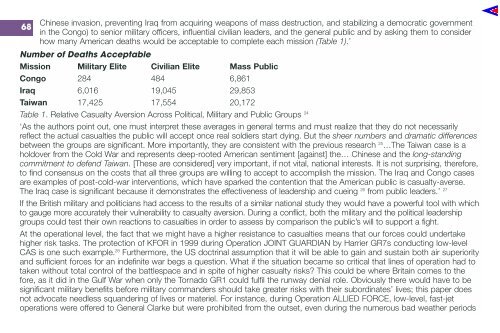Volume 5 No 2 - Royal Air Force Centre for Air Power Studies
Volume 5 No 2 - Royal Air Force Centre for Air Power Studies
Volume 5 No 2 - Royal Air Force Centre for Air Power Studies
Create successful ePaper yourself
Turn your PDF publications into a flip-book with our unique Google optimized e-Paper software.
68<br />
Chinese invasion, preventing Iraq from acquiring weapons of mass destruction, and stabilizing a democratic government<br />
in the Congo) to senior military officers, influential civilian leaders, and the general public and by asking them to consider<br />
how many American deaths would be acceptable to complete each mission (Table 1).’<br />
Number of Deaths Acceptable<br />
Mission Military Elite Civilian Elite Mass Public<br />
Congo 284 484 6,861<br />
Iraq 6,016 19,045 29,853<br />
Taiwan 17,425 17,554 20,172<br />
Table 1. Relative Casualty Aversion Across Political, Military and Public Groups 24<br />
‘As the authors point out, one must interpret these averages in general terms and must realize that they do not necessarily<br />
reflect the actual casualties the public will accept once real soldiers start dying. But the sheer numbers and dramatic differences<br />
between the groups are significant. More importantly, they are consistent with the previous research 25 …The Taiwan case is a<br />
holdover from the Cold War and represents deep-rooted American sentiment [against] the… Chinese and the long-standing<br />
commitment to defend Taiwan. [These are considered] very important, if not vital, national interests. It is not surprising, there<strong>for</strong>e,<br />
to find consensus on the costs that all three groups are willing to accept to accomplish the mission. The Iraq and Congo cases<br />
are examples of post-cold-war interventions, which have sparked the contention that the American public is casualty-averse.<br />
The Iraq case is significant because it demonstrates the effectiveness of leadership and cueing 26 from public leaders.’ 27<br />
If the British military and politicians had access to the results of a similar national study they would have a powerful tool with which<br />
to gauge more accurately their vulnerability to casualty aversion. During a conflict, both the military and the political leadership<br />
groups could test their own reactions to casualties in order to assess by comparison the public’s will to support a fight.<br />
At the operational level, the fact that we might have a higher resistance to casualties means that our <strong>for</strong>ces could undertake<br />
higher risk tasks. The protection of KFOR in 1999 during Operation JOINT GUARDIAN by Harrier GR7s conducting low-level<br />
CAS is one such example. 28 Furthermore, the US doctrinal assumption that it will be able to gain and sustain both air superiority<br />
and sufficient <strong>for</strong>ces <strong>for</strong> an indefinite war begs a question. What if the situation became so critical that lines of operation had to<br />
taken without total control of the battlespace and in spite of higher casualty risks? This could be where Britain comes to the<br />
<strong>for</strong>e, as it did in the Gulf War when only the Tornado GR1 could fulfil the runway denial role. Obviously there would have to be<br />
significant military benefits be<strong>for</strong>e military commanders should take greater risks with their subordinates’ lives; this paper does<br />
not advocate needless squandering of lives or materiel. For instance, during Operation ALLIED FORCE, low-level, fast-jet<br />
operations were offered to General Clarke but were prohibited from the outset, even during the numerous bad weather periods
















